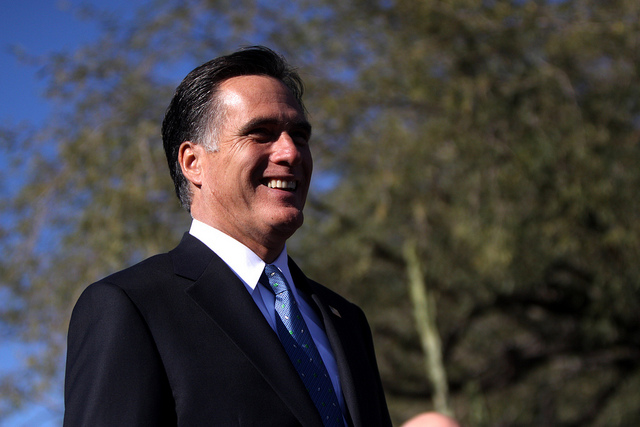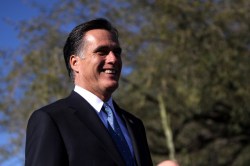Everyone knows that “Obamacare” was modeled on Mitt Romney’s Massachusetts health-care law. But did you know that a key Obama “smart growth” initiative — the Partnership for Sustainable Communities — was also created in the mold of a Romney program?
Tea Partiers rallied to quash funding for this Obama partnership last fall. Rep. Paul Ryan (R-Wis.), conservative darling, criticized the idea for the partnership when it first arose and accused the Obama administration of trying to impose “an urban-utopian fantasy through an unprecedented intrusion of the Federal Government into the shaping of local communities.” The Republican National Committee recently warned that smart growth is part of a U.N. conspiracy (green helicopters, anyone?).
This is yet another issue on which the party’s presumptive presidential nominee looks to be seriously out of sync with the GOP base.
Romney’s “get smart” phase
As governor of Massachusetts, Romney actively fought sprawl and promoted density. He ran on a smart-growth platform: “Sprawl is the most important quality-of-life issue facing Massachusetts,” he said in 2002.
After winning, Romney swiftly set about remaking state government to encourage smarter land use. He created a powerful new Office for Commonwealth Development, and appointed an aggressive environmental activist to run it — Douglas Foy, who for 25 years had headed the Conservation Law Foundation, a litigious regional environmental group. The state’s business community was appalled.
The Office for Commonwealth Development served as a “super-secretariat” or umbrella office for state agencies dealing with transportation, housing, energy, and the environment. It made sure the agencies were all pulling in the same direction toward smart-growth goals — concentrating development in town centers, constructing housing near transit stations, fixing existing roads instead of building new ones.
“I think [Romney] views sprawl as inefficient land use, and he’s all about efficiency. From a business perspective, he thinks smart growth makes a lot of sense,” says Anthony Flint, who served as a policy advisor in the Office for Commonwealth Development under Romney, and is now a fellow at the Lincoln Institute of Land Policy, a think tank in Cambridge, Mass.
The Romney administration pursued smart growth not through strict regulation but through incentives. The Office for Commonwealth Development channeled hundreds of millions in state funds to cities and towns that changed zoning rules to allow more high-density housing and adopted other smart-growth policies.
Romney was a vocal advocate for the cause. “I very much believe in the concept known as smart growth or sustainable development, which is the phrase I used in the campaign,” Romney told CommonWealth magazine in 2003. “You do not want to deplete your green space and air and water [in order] to grow, and the only way that’s possible is if your growth is done in a thoughtful, coherent, strategic way.”
As Romney put it in 2005, “By targeting development to areas where there is already infrastructure in place, not only can we revitalize our older communities, but we can also curb sprawl as well.” His administration actively pursued a “sustainable development agenda” and promoted “transit-oriented development,” “multi-modal transportation,” “village-style zoning,” “green building,” “mixed-use” development, “mixed-income housing,” and other approaches that would delight any green-leaning city planner — and rile up any red-blooded Tea Partier.
Environmental activists still found plenty to criticize in Romney’s approach to land use and development, but many greens and smart-growth advocates were pleasantly surprised, at least in the first half of Romney’s term. In 2006, the U.S. EPA gave Massachusetts’ Office for Commonwealth Development its National Award for Smart Growth Achievement.
Obama follows Romney’s lead
Under President Obama, the EPA moved from praising Romney’s smart-growth office to mimicking it.
In June 2009, the Obama team created the Partnership for Sustainable Communities in the silo-busting mold of Romney’s Office for Commonwealth Development. The partnership brings together the EPA, the Department of Transportation, and the Department of Housing and Urban Development to jointly promote smart growth.
“We want to make sure that when we’re building infrastructure, we’re considering how housing, transportation, and the environment all impact each other,” Obama explained in 2010, sounding an awful lot like the Romney of yore.
Just as Romney’s Office for Commonwealth Development incentivized local communities to embrace smart growth by offering grants, so does the Partnership for Sustainable Communities. Since its launch, the partnership has helped to allocate about $3.5 billion in grants and other assistance to more than 700 communities that want to better coordinate housing, transportation, and economic-development projects and make neighborhoods more walkable, transit-accessible, and sustainable.
Tea Partiers go nuts
You might think this all sounds benign or common sense, or even classically conservative — conserving land, conserving gas, and conserving taxpayer dollars by preventing the construction of new roads and sewer systems for sprawling new communities. But that’s not how today’s Republican Party sees it.
Tea Partiers are fighting smart-growth programs tooth and nail, believing them to be part of an insidious U.N. plot. Their fears center around a once-obscure, non-binding U.N. sustainability plan called Agenda 21, which came out of the 1992 Rio Earth Summit and called for, among other things, “fulfillment of basic needs, improved living standards for all, better protected and managed ecosystems” and — gasp! — “sustainable land-use planning and management.” Like most non-binding U.N. documents — in fact, like most binding U.N. documents — Agenda 21 was widely ignored. That is, until American right-wingers latched onto it a few years ago.
Last fall, Tea Partiers erroneously linked Obama’s Partnership for Sustainable Communities to Agenda 21, and groups around the country mobilized to fight its funding in Congress. “This funding has been using YOUR tax dollars to promote the United Nations’ plan to control our government,” warned the Gainsville Tea Party. It’s an “assault on property rights and America’s way of life,” railed the Sandia Tea Party of New Mexico. “STOP THE GRAVY TRAIN!!!” demanded the Southwest Virginia Tea Party. Congress did cut some funding for the partnership’s grant making, but the partnership lives on and continues to help allocate funds to local communities.
Meanwhile, as the Agenda 21 conspiracy theorizing has grown louder over the past year, big-name Republicans have joined in. Newt Gingrich inveighed against Agenda 21 on the campaign trail last year, and even mentioned it during a debate in November. That same month, Rick Santorum warned about Agenda 21 in a Facebook post.
In January, the Republican National Committee adopted a resolution “exposing” Agenda 21 as a “comprehensive plan of extreme environmentalism, social engineering, and global political control.” In an apparent slam against the Sustainable Communities grant program, the resolution called for “rejection of any grant monies” linked to Agenda 21. The resolution could make it into the official Republican Party platform that will be decided upon at the national convention in August.
Where’s Mitt now?
As you might expect, Romney has not been talking about sprawl or smart growth on the campaign trail, and his campaign did not respond to a request for comment.
With other issues — like health care, abortion, and immigration — Romney has flip-flopped from the centrist views he held as governor to right-wing positions now preferred by the GOP base. Because smart growth hasn’t risen to the level of national discussion, Romney hasn’t had to clarify his position on this topic.
Romney told a small group of donors last week that he might completely eliminate one of the departments involved in the Partnership for Sustainable Communities — HUD, which his father headed during the Nixon administration. A few months ago, Romney said the EPA under Obama was “out of control,” though he’s stopped short of calling for it to be abolished. Considering those views, it seems highly unlikely that Romney would want anything like the partnership operating under his watch.
Perhaps, in the same way he has defended his Massachusetts health-care program, Romney would argue that pursuing smart growth at the state level makes sense while doing so at the federal level would be overreach. But as both Romney’s Office for Commonwealth Development and Obama’s Partnership for Sustainable Communities used taxpayer dollars to influence what local communities do, is there really such a dramatic distinction between them?
People who worked with or closely observed Romney during his governorship aren’t sure what his current, or “real,” views on smart growth are.
Foy, the first head of Romney’s Office for Commonwealth Development, recently told The New Republic, “I’m proud of what we did, and I think he’s proud of what we did.” But Foy quit the administration after three years, shortly following Romney’s surprise move to pull Massachusetts out of a Northeast cap-and-trade program that Foy had helped to develop, the Regional Greenhouse Gas Initiative.
Jack Clarke, director of public policy at Mass Audubon and a former environmental official under Massachusetts Gov. William Weld (R), credits Romney with appointing good people to work on smart growth, but says “it wasn’t a core value” for the governor. He doesn’t believe Romney would do anything to advance the cause as president.
Flint, who worked under Foy, says, “Romney the governor was very active on the environment and smart growth and, for a time, climate change.” And now? “His positions on those topics have certainly changed, so I’m not sure what to think.”




